Operations and Project Management Report: Sainsbury's Analysis
VerifiedAdded on 2023/01/16
|19
|5934
|61
Report
AI Summary
This report delves into the application of operations and project management principles within the context of Sainsbury's, a major UK supermarket chain. It begins by defining operations and project management and then explores the implementation of key operations management principles, such as reality, accountability, change, and quality control, within Sainsbury's. The report examines how Sainsbury's utilizes tools like lean principles and Six Sigma to address operational issues such as cost management, safety, delivery, and quality control. The report also includes a continuous improvement plan, focusing on the philosophy and implementation of continuous improvement strategies. The second part of the report focuses on project management, outlining the stages of the project life cycle and the necessary documentation. It then assesses the effectiveness of the project life cycle using various theories, models, and concepts. The analysis provides a comprehensive understanding of how Sainsbury's manages its operations and projects, incorporating a range of management principles and methodologies to improve efficiency and achieve its objectives. The report concludes with a review of key findings and recommendations for improvement.
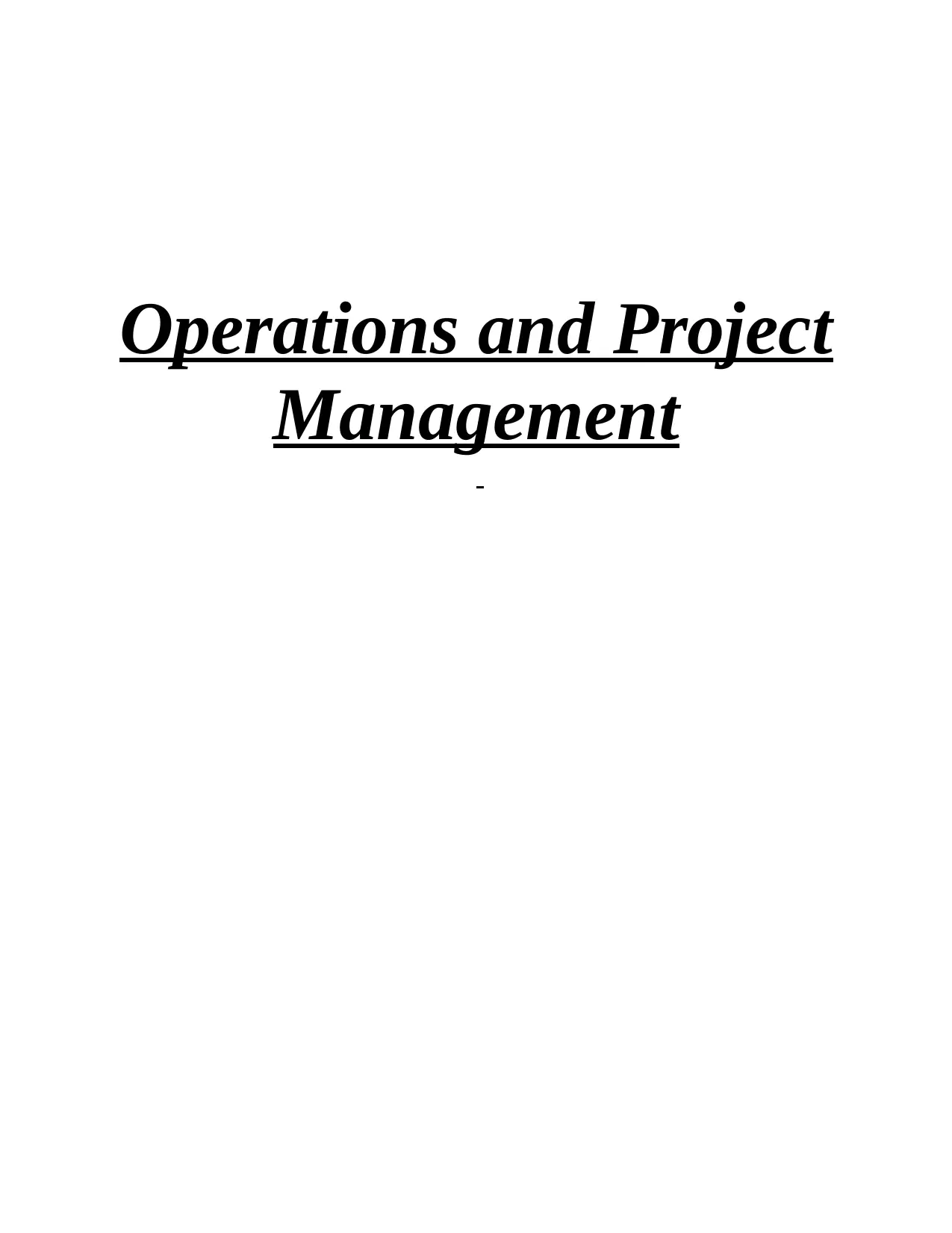
Operations and Project
Management
Management
Paraphrase This Document
Need a fresh take? Get an instant paraphrase of this document with our AI Paraphraser
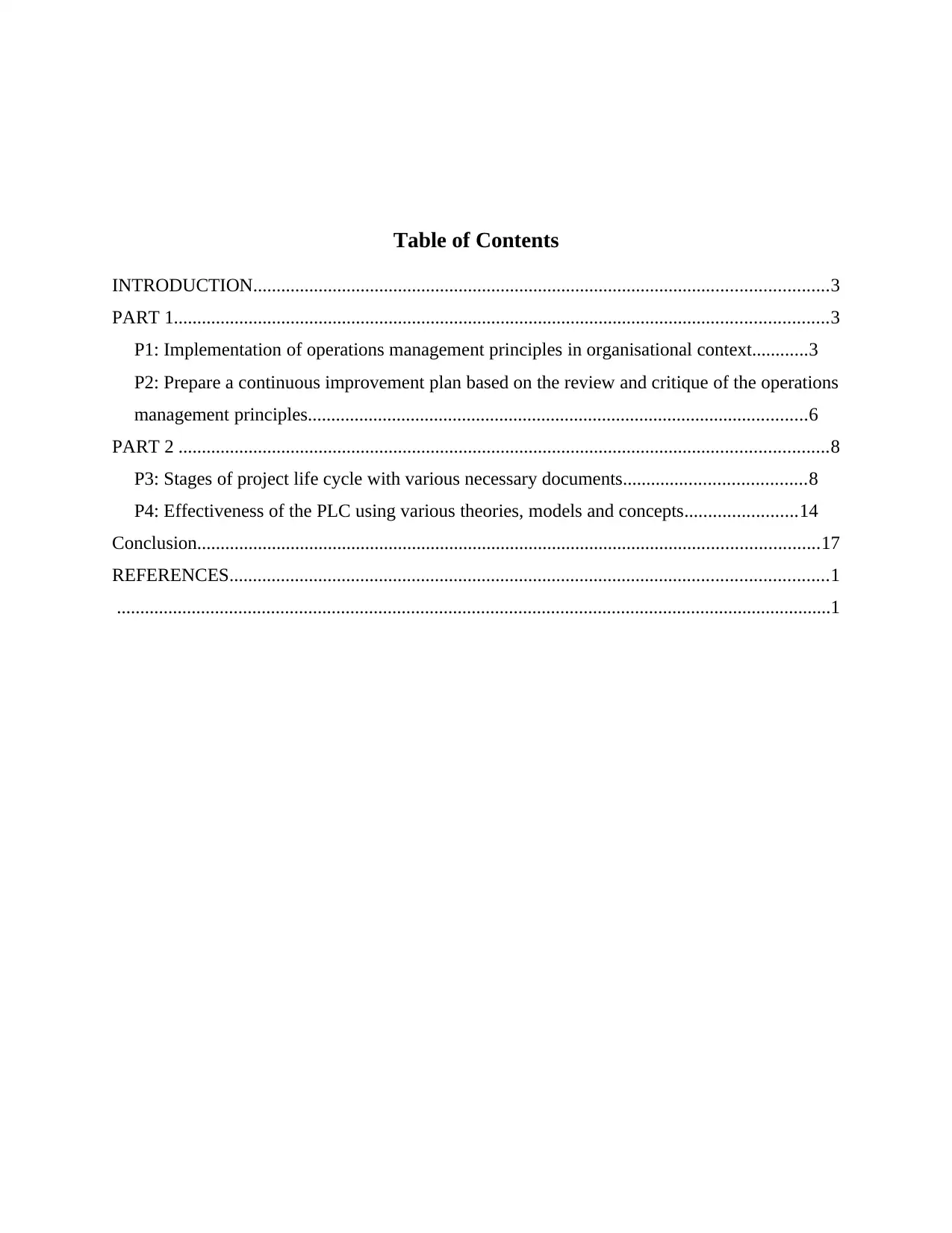
Table of Contents
INTRODUCTION...........................................................................................................................3
PART 1............................................................................................................................................3
P1: Implementation of operations management principles in organisational context............3
P2: Prepare a continuous improvement plan based on the review and critique of the operations
management principles...........................................................................................................6
PART 2 ...........................................................................................................................................8
P3: Stages of project life cycle with various necessary documents.......................................8
P4: Effectiveness of the PLC using various theories, models and concepts........................14
Conclusion.....................................................................................................................................17
REFERENCES................................................................................................................................1
.........................................................................................................................................................1
INTRODUCTION...........................................................................................................................3
PART 1............................................................................................................................................3
P1: Implementation of operations management principles in organisational context............3
P2: Prepare a continuous improvement plan based on the review and critique of the operations
management principles...........................................................................................................6
PART 2 ...........................................................................................................................................8
P3: Stages of project life cycle with various necessary documents.......................................8
P4: Effectiveness of the PLC using various theories, models and concepts........................14
Conclusion.....................................................................................................................................17
REFERENCES................................................................................................................................1
.........................................................................................................................................................1
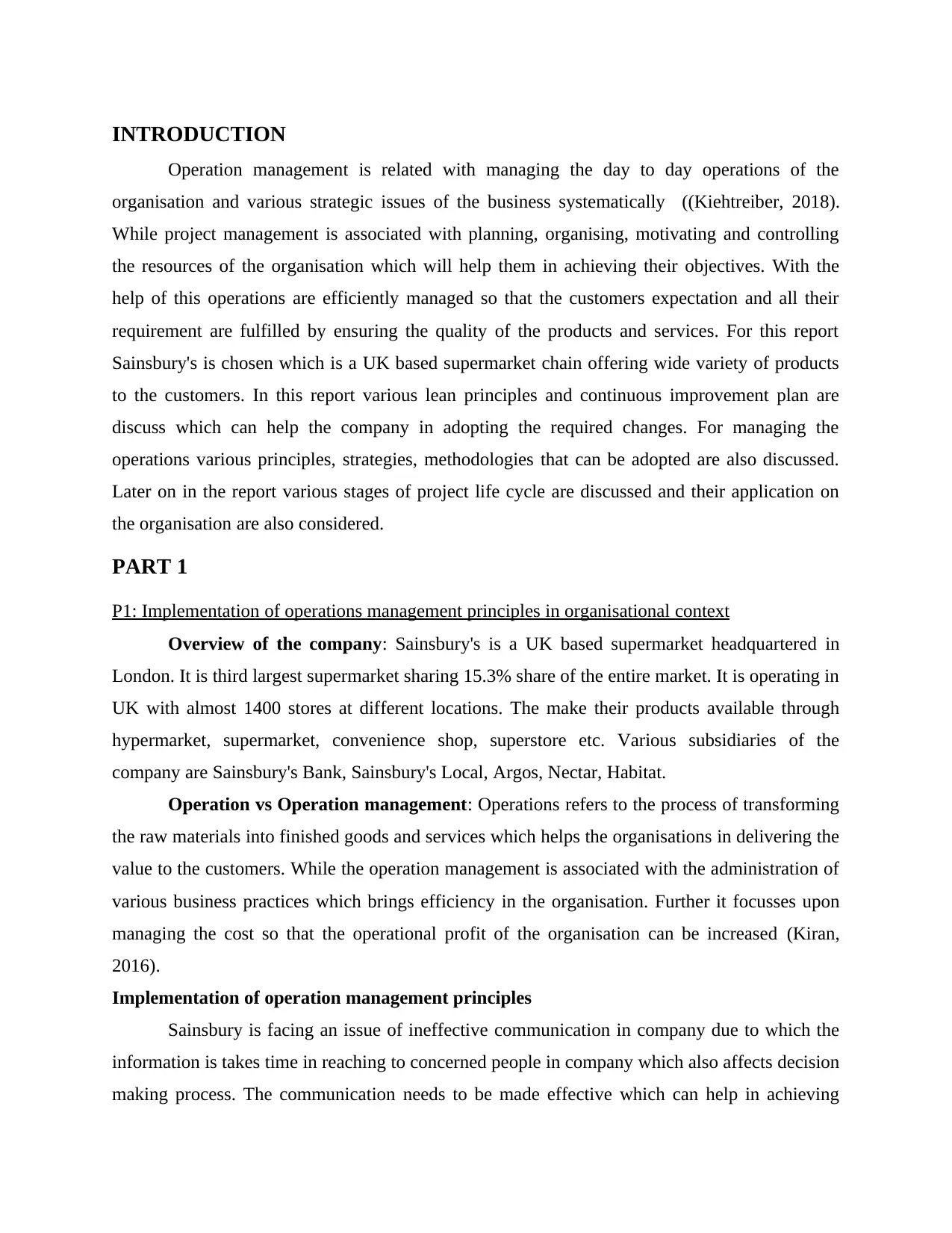
INTRODUCTION
Operation management is related with managing the day to day operations of the
organisation and various strategic issues of the business systematically ((Kiehtreiber, 2018).
While project management is associated with planning, organising, motivating and controlling
the resources of the organisation which will help them in achieving their objectives. With the
help of this operations are efficiently managed so that the customers expectation and all their
requirement are fulfilled by ensuring the quality of the products and services. For this report
Sainsbury's is chosen which is a UK based supermarket chain offering wide variety of products
to the customers. In this report various lean principles and continuous improvement plan are
discuss which can help the company in adopting the required changes. For managing the
operations various principles, strategies, methodologies that can be adopted are also discussed.
Later on in the report various stages of project life cycle are discussed and their application on
the organisation are also considered.
PART 1
P1: Implementation of operations management principles in organisational context
Overview of the company: Sainsbury's is a UK based supermarket headquartered in
London. It is third largest supermarket sharing 15.3% share of the entire market. It is operating in
UK with almost 1400 stores at different locations. The make their products available through
hypermarket, supermarket, convenience shop, superstore etc. Various subsidiaries of the
company are Sainsbury's Bank, Sainsbury's Local, Argos, Nectar, Habitat.
Operation vs Operation management: Operations refers to the process of transforming
the raw materials into finished goods and services which helps the organisations in delivering the
value to the customers. While the operation management is associated with the administration of
various business practices which brings efficiency in the organisation. Further it focusses upon
managing the cost so that the operational profit of the organisation can be increased (Kiran,
2016).
Implementation of operation management principles
Sainsbury is facing an issue of ineffective communication in company due to which the
information is takes time in reaching to concerned people in company which also affects decision
making process. The communication needs to be made effective which can help in achieving
Operation management is related with managing the day to day operations of the
organisation and various strategic issues of the business systematically ((Kiehtreiber, 2018).
While project management is associated with planning, organising, motivating and controlling
the resources of the organisation which will help them in achieving their objectives. With the
help of this operations are efficiently managed so that the customers expectation and all their
requirement are fulfilled by ensuring the quality of the products and services. For this report
Sainsbury's is chosen which is a UK based supermarket chain offering wide variety of products
to the customers. In this report various lean principles and continuous improvement plan are
discuss which can help the company in adopting the required changes. For managing the
operations various principles, strategies, methodologies that can be adopted are also discussed.
Later on in the report various stages of project life cycle are discussed and their application on
the organisation are also considered.
PART 1
P1: Implementation of operations management principles in organisational context
Overview of the company: Sainsbury's is a UK based supermarket headquartered in
London. It is third largest supermarket sharing 15.3% share of the entire market. It is operating in
UK with almost 1400 stores at different locations. The make their products available through
hypermarket, supermarket, convenience shop, superstore etc. Various subsidiaries of the
company are Sainsbury's Bank, Sainsbury's Local, Argos, Nectar, Habitat.
Operation vs Operation management: Operations refers to the process of transforming
the raw materials into finished goods and services which helps the organisations in delivering the
value to the customers. While the operation management is associated with the administration of
various business practices which brings efficiency in the organisation. Further it focusses upon
managing the cost so that the operational profit of the organisation can be increased (Kiran,
2016).
Implementation of operation management principles
Sainsbury is facing an issue of ineffective communication in company due to which the
information is takes time in reaching to concerned people in company which also affects decision
making process. The communication needs to be made effective which can help in achieving
⊘ This is a preview!⊘
Do you want full access?
Subscribe today to unlock all pages.

Trusted by 1+ million students worldwide
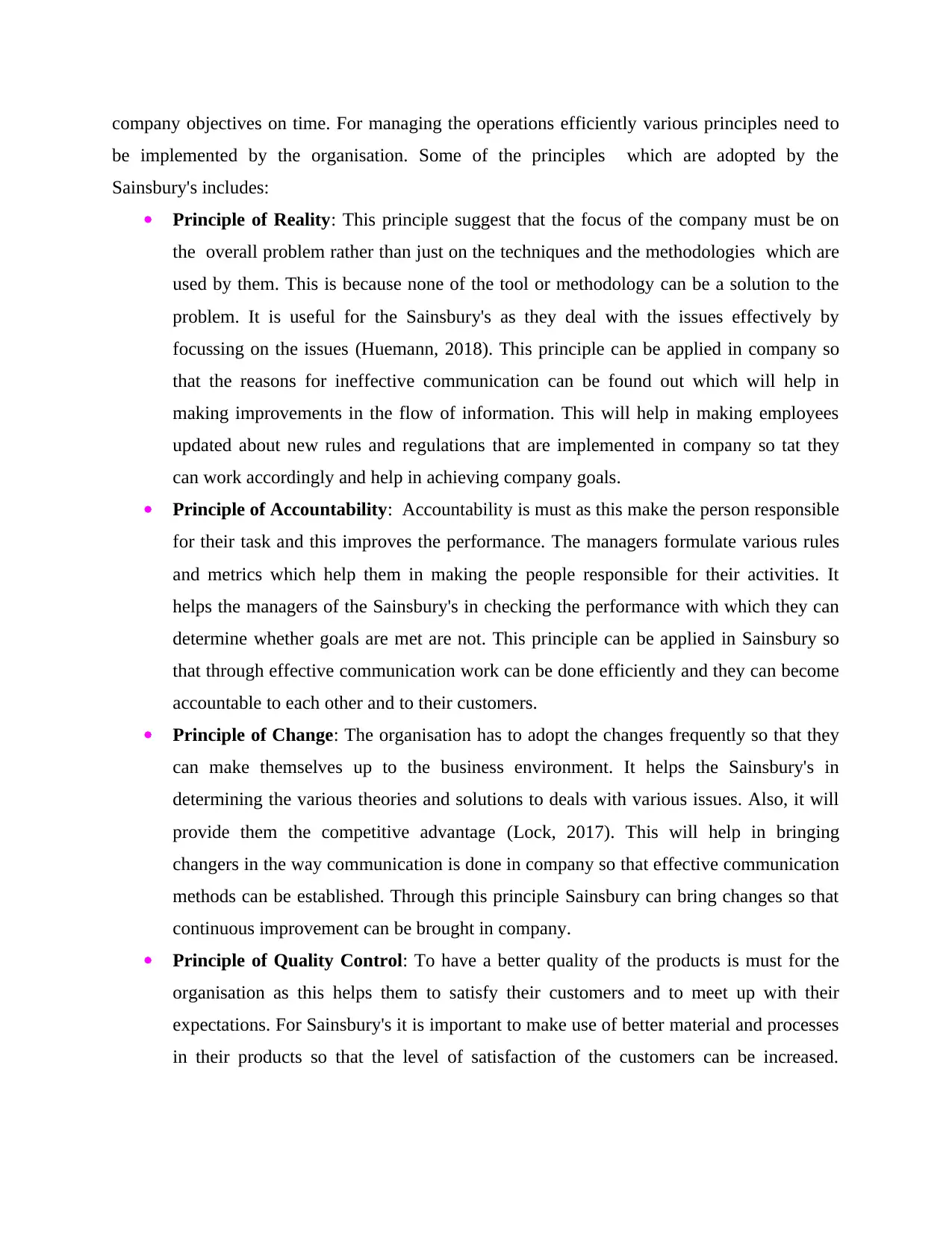
company objectives on time. For managing the operations efficiently various principles need to
be implemented by the organisation. Some of the principles which are adopted by the
Sainsbury's includes:
Principle of Reality: This principle suggest that the focus of the company must be on
the overall problem rather than just on the techniques and the methodologies which are
used by them. This is because none of the tool or methodology can be a solution to the
problem. It is useful for the Sainsbury's as they deal with the issues effectively by
focussing on the issues (Huemann, 2018). This principle can be applied in company so
that the reasons for ineffective communication can be found out which will help in
making improvements in the flow of information. This will help in making employees
updated about new rules and regulations that are implemented in company so tat they
can work accordingly and help in achieving company goals.
Principle of Accountability: Accountability is must as this make the person responsible
for their task and this improves the performance. The managers formulate various rules
and metrics which help them in making the people responsible for their activities. It
helps the managers of the Sainsbury's in checking the performance with which they can
determine whether goals are met are not. This principle can be applied in Sainsbury so
that through effective communication work can be done efficiently and they can become
accountable to each other and to their customers.
Principle of Change: The organisation has to adopt the changes frequently so that they
can make themselves up to the business environment. It helps the Sainsbury's in
determining the various theories and solutions to deals with various issues. Also, it will
provide them the competitive advantage (Lock, 2017). This will help in bringing
changers in the way communication is done in company so that effective communication
methods can be established. Through this principle Sainsbury can bring changes so that
continuous improvement can be brought in company.
Principle of Quality Control: To have a better quality of the products is must for the
organisation as this helps them to satisfy their customers and to meet up with their
expectations. For Sainsbury's it is important to make use of better material and processes
in their products so that the level of satisfaction of the customers can be increased.
be implemented by the organisation. Some of the principles which are adopted by the
Sainsbury's includes:
Principle of Reality: This principle suggest that the focus of the company must be on
the overall problem rather than just on the techniques and the methodologies which are
used by them. This is because none of the tool or methodology can be a solution to the
problem. It is useful for the Sainsbury's as they deal with the issues effectively by
focussing on the issues (Huemann, 2018). This principle can be applied in company so
that the reasons for ineffective communication can be found out which will help in
making improvements in the flow of information. This will help in making employees
updated about new rules and regulations that are implemented in company so tat they
can work accordingly and help in achieving company goals.
Principle of Accountability: Accountability is must as this make the person responsible
for their task and this improves the performance. The managers formulate various rules
and metrics which help them in making the people responsible for their activities. It
helps the managers of the Sainsbury's in checking the performance with which they can
determine whether goals are met are not. This principle can be applied in Sainsbury so
that through effective communication work can be done efficiently and they can become
accountable to each other and to their customers.
Principle of Change: The organisation has to adopt the changes frequently so that they
can make themselves up to the business environment. It helps the Sainsbury's in
determining the various theories and solutions to deals with various issues. Also, it will
provide them the competitive advantage (Lock, 2017). This will help in bringing
changers in the way communication is done in company so that effective communication
methods can be established. Through this principle Sainsbury can bring changes so that
continuous improvement can be brought in company.
Principle of Quality Control: To have a better quality of the products is must for the
organisation as this helps them to satisfy their customers and to meet up with their
expectations. For Sainsbury's it is important to make use of better material and processes
in their products so that the level of satisfaction of the customers can be increased.
Paraphrase This Document
Need a fresh take? Get an instant paraphrase of this document with our AI Paraphraser
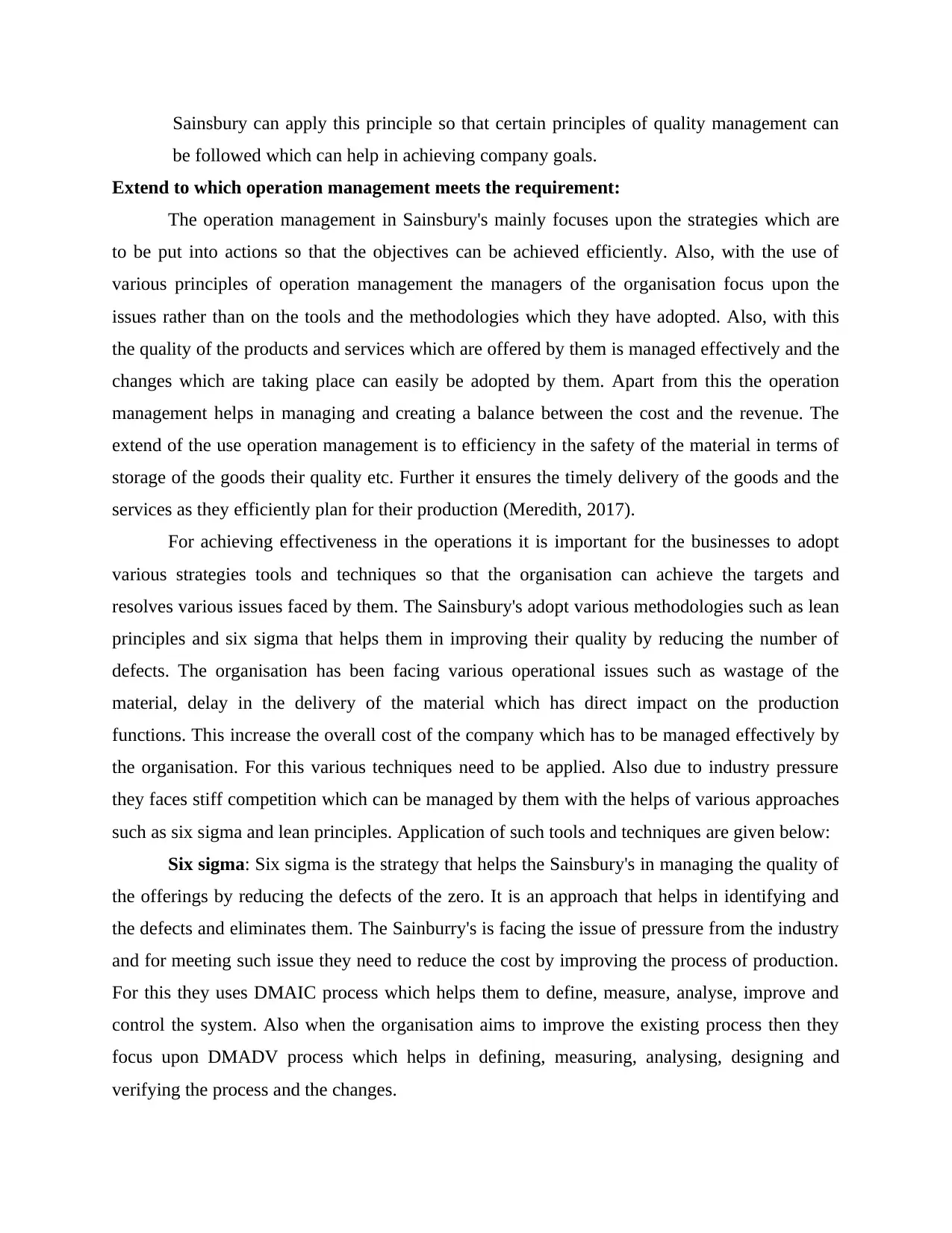
Sainsbury can apply this principle so that certain principles of quality management can
be followed which can help in achieving company goals.
Extend to which operation management meets the requirement:
The operation management in Sainsbury's mainly focuses upon the strategies which are
to be put into actions so that the objectives can be achieved efficiently. Also, with the use of
various principles of operation management the managers of the organisation focus upon the
issues rather than on the tools and the methodologies which they have adopted. Also, with this
the quality of the products and services which are offered by them is managed effectively and the
changes which are taking place can easily be adopted by them. Apart from this the operation
management helps in managing and creating a balance between the cost and the revenue. The
extend of the use operation management is to efficiency in the safety of the material in terms of
storage of the goods their quality etc. Further it ensures the timely delivery of the goods and the
services as they efficiently plan for their production (Meredith, 2017).
For achieving effectiveness in the operations it is important for the businesses to adopt
various strategies tools and techniques so that the organisation can achieve the targets and
resolves various issues faced by them. The Sainsbury's adopt various methodologies such as lean
principles and six sigma that helps them in improving their quality by reducing the number of
defects. The organisation has been facing various operational issues such as wastage of the
material, delay in the delivery of the material which has direct impact on the production
functions. This increase the overall cost of the company which has to be managed effectively by
the organisation. For this various techniques need to be applied. Also due to industry pressure
they faces stiff competition which can be managed by them with the helps of various approaches
such as six sigma and lean principles. Application of such tools and techniques are given below:
Six sigma: Six sigma is the strategy that helps the Sainsbury's in managing the quality of
the offerings by reducing the defects of the zero. It is an approach that helps in identifying and
the defects and eliminates them. The Sainburry's is facing the issue of pressure from the industry
and for meeting such issue they need to reduce the cost by improving the process of production.
For this they uses DMAIC process which helps them to define, measure, analyse, improve and
control the system. Also when the organisation aims to improve the existing process then they
focus upon DMADV process which helps in defining, measuring, analysing, designing and
verifying the process and the changes.
be followed which can help in achieving company goals.
Extend to which operation management meets the requirement:
The operation management in Sainsbury's mainly focuses upon the strategies which are
to be put into actions so that the objectives can be achieved efficiently. Also, with the use of
various principles of operation management the managers of the organisation focus upon the
issues rather than on the tools and the methodologies which they have adopted. Also, with this
the quality of the products and services which are offered by them is managed effectively and the
changes which are taking place can easily be adopted by them. Apart from this the operation
management helps in managing and creating a balance between the cost and the revenue. The
extend of the use operation management is to efficiency in the safety of the material in terms of
storage of the goods their quality etc. Further it ensures the timely delivery of the goods and the
services as they efficiently plan for their production (Meredith, 2017).
For achieving effectiveness in the operations it is important for the businesses to adopt
various strategies tools and techniques so that the organisation can achieve the targets and
resolves various issues faced by them. The Sainsbury's adopt various methodologies such as lean
principles and six sigma that helps them in improving their quality by reducing the number of
defects. The organisation has been facing various operational issues such as wastage of the
material, delay in the delivery of the material which has direct impact on the production
functions. This increase the overall cost of the company which has to be managed effectively by
the organisation. For this various techniques need to be applied. Also due to industry pressure
they faces stiff competition which can be managed by them with the helps of various approaches
such as six sigma and lean principles. Application of such tools and techniques are given below:
Six sigma: Six sigma is the strategy that helps the Sainsbury's in managing the quality of
the offerings by reducing the defects of the zero. It is an approach that helps in identifying and
the defects and eliminates them. The Sainburry's is facing the issue of pressure from the industry
and for meeting such issue they need to reduce the cost by improving the process of production.
For this they uses DMAIC process which helps them to define, measure, analyse, improve and
control the system. Also when the organisation aims to improve the existing process then they
focus upon DMADV process which helps in defining, measuring, analysing, designing and
verifying the process and the changes.
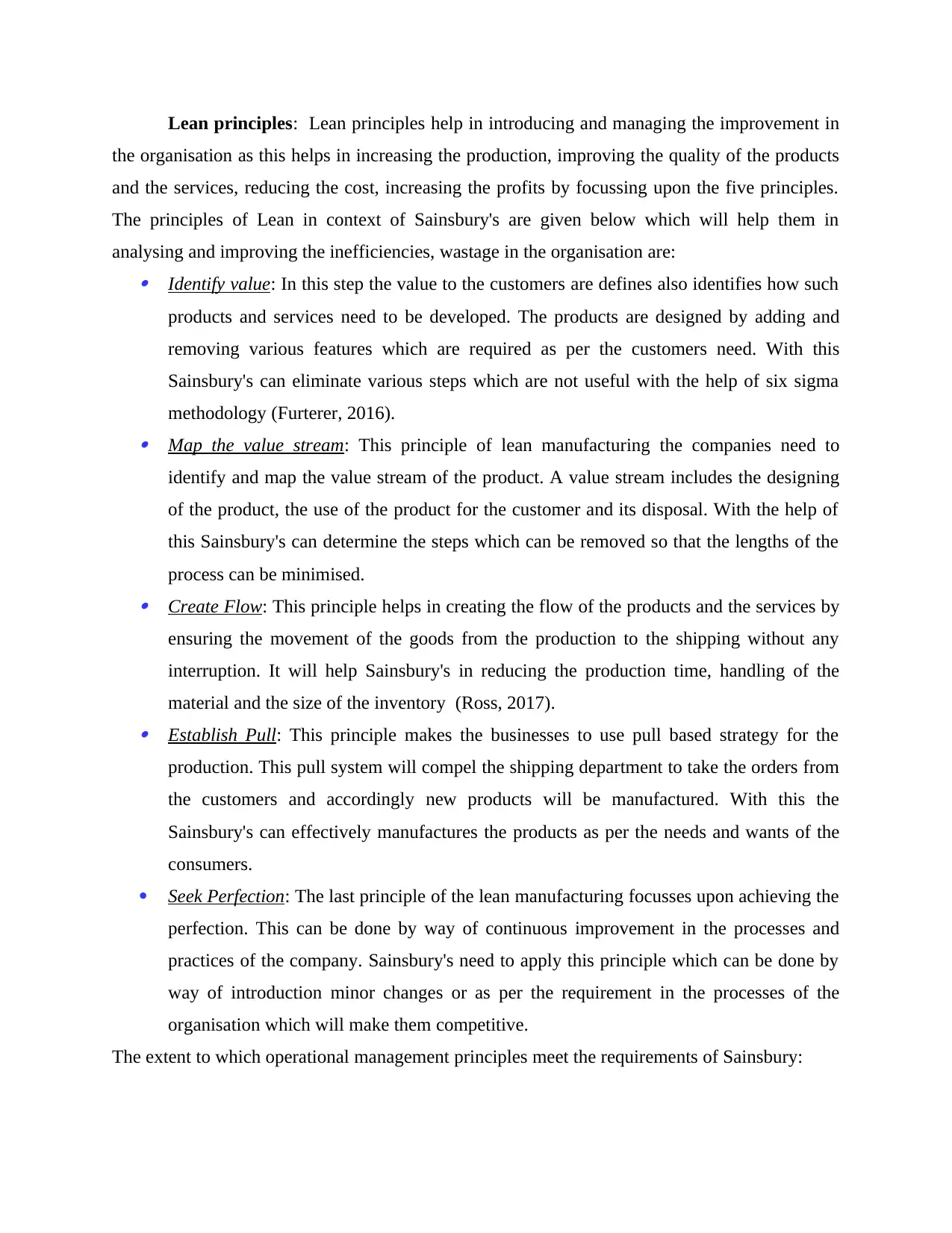
Lean principles: Lean principles help in introducing and managing the improvement in
the organisation as this helps in increasing the production, improving the quality of the products
and the services, reducing the cost, increasing the profits by focussing upon the five principles.
The principles of Lean in context of Sainsbury's are given below which will help them in
analysing and improving the inefficiencies, wastage in the organisation are: Identify value: In this step the value to the customers are defines also identifies how such
products and services need to be developed. The products are designed by adding and
removing various features which are required as per the customers need. With this
Sainsbury's can eliminate various steps which are not useful with the help of six sigma
methodology (Furterer, 2016). Map the value stream: This principle of lean manufacturing the companies need to
identify and map the value stream of the product. A value stream includes the designing
of the product, the use of the product for the customer and its disposal. With the help of
this Sainsbury's can determine the steps which can be removed so that the lengths of the
process can be minimised. Create Flow: This principle helps in creating the flow of the products and the services by
ensuring the movement of the goods from the production to the shipping without any
interruption. It will help Sainsbury's in reducing the production time, handling of the
material and the size of the inventory (Ross, 2017). Establish Pull: This principle makes the businesses to use pull based strategy for the
production. This pull system will compel the shipping department to take the orders from
the customers and accordingly new products will be manufactured. With this the
Sainsbury's can effectively manufactures the products as per the needs and wants of the
consumers.
Seek Perfection: The last principle of the lean manufacturing focusses upon achieving the
perfection. This can be done by way of continuous improvement in the processes and
practices of the company. Sainsbury's need to apply this principle which can be done by
way of introduction minor changes or as per the requirement in the processes of the
organisation which will make them competitive.
The extent to which operational management principles meet the requirements of Sainsbury:
the organisation as this helps in increasing the production, improving the quality of the products
and the services, reducing the cost, increasing the profits by focussing upon the five principles.
The principles of Lean in context of Sainsbury's are given below which will help them in
analysing and improving the inefficiencies, wastage in the organisation are: Identify value: In this step the value to the customers are defines also identifies how such
products and services need to be developed. The products are designed by adding and
removing various features which are required as per the customers need. With this
Sainsbury's can eliminate various steps which are not useful with the help of six sigma
methodology (Furterer, 2016). Map the value stream: This principle of lean manufacturing the companies need to
identify and map the value stream of the product. A value stream includes the designing
of the product, the use of the product for the customer and its disposal. With the help of
this Sainsbury's can determine the steps which can be removed so that the lengths of the
process can be minimised. Create Flow: This principle helps in creating the flow of the products and the services by
ensuring the movement of the goods from the production to the shipping without any
interruption. It will help Sainsbury's in reducing the production time, handling of the
material and the size of the inventory (Ross, 2017). Establish Pull: This principle makes the businesses to use pull based strategy for the
production. This pull system will compel the shipping department to take the orders from
the customers and accordingly new products will be manufactured. With this the
Sainsbury's can effectively manufactures the products as per the needs and wants of the
consumers.
Seek Perfection: The last principle of the lean manufacturing focusses upon achieving the
perfection. This can be done by way of continuous improvement in the processes and
practices of the company. Sainsbury's need to apply this principle which can be done by
way of introduction minor changes or as per the requirement in the processes of the
organisation which will make them competitive.
The extent to which operational management principles meet the requirements of Sainsbury:
⊘ This is a preview!⊘
Do you want full access?
Subscribe today to unlock all pages.

Trusted by 1+ million students worldwide
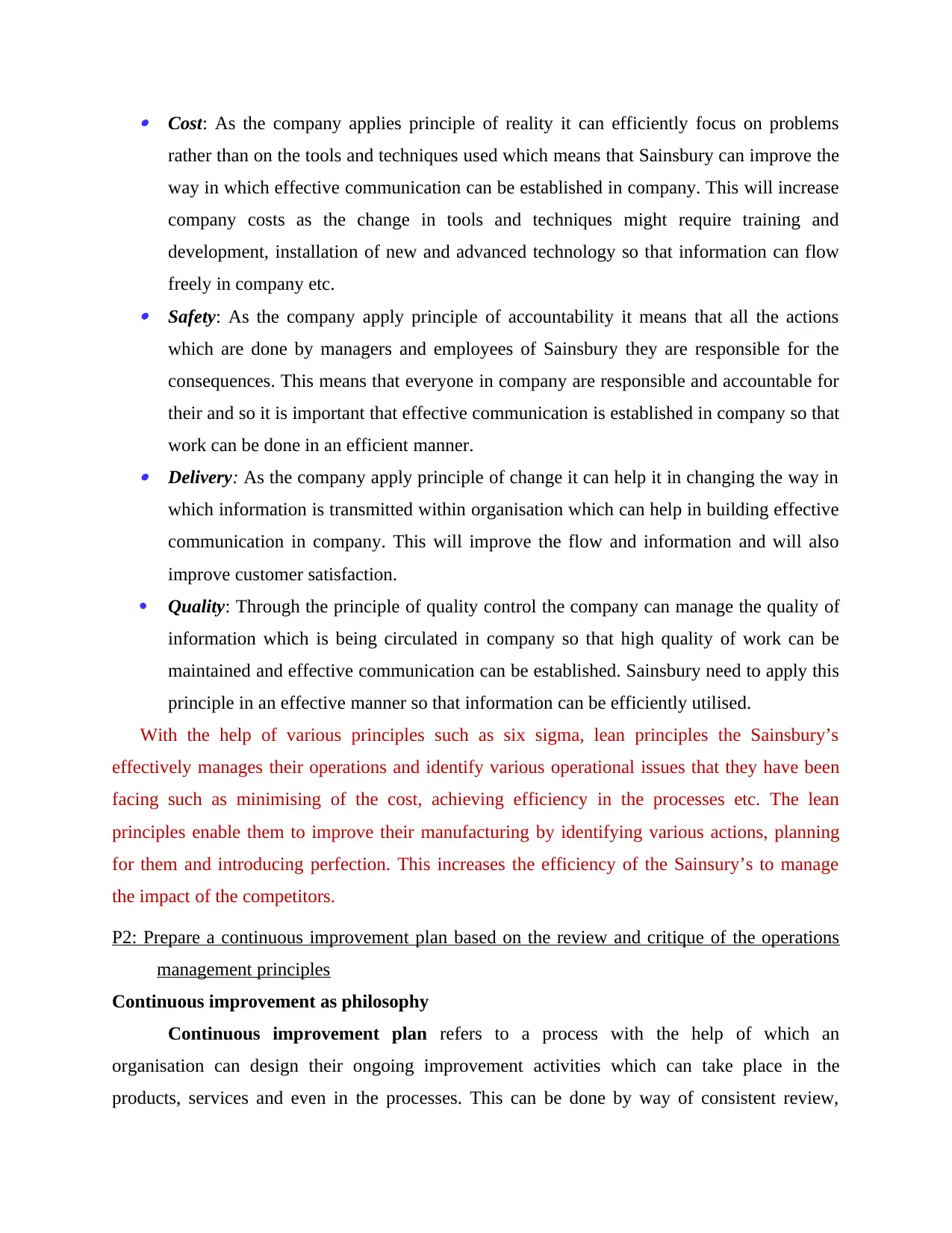
Cost: As the company applies principle of reality it can efficiently focus on problems
rather than on the tools and techniques used which means that Sainsbury can improve the
way in which effective communication can be established in company. This will increase
company costs as the change in tools and techniques might require training and
development, installation of new and advanced technology so that information can flow
freely in company etc. Safety: As the company apply principle of accountability it means that all the actions
which are done by managers and employees of Sainsbury they are responsible for the
consequences. This means that everyone in company are responsible and accountable for
their and so it is important that effective communication is established in company so that
work can be done in an efficient manner. Delivery: As the company apply principle of change it can help it in changing the way in
which information is transmitted within organisation which can help in building effective
communication in company. This will improve the flow and information and will also
improve customer satisfaction.
Quality: Through the principle of quality control the company can manage the quality of
information which is being circulated in company so that high quality of work can be
maintained and effective communication can be established. Sainsbury need to apply this
principle in an effective manner so that information can be efficiently utilised.
With the help of various principles such as six sigma, lean principles the Sainsbury’s
effectively manages their operations and identify various operational issues that they have been
facing such as minimising of the cost, achieving efficiency in the processes etc. The lean
principles enable them to improve their manufacturing by identifying various actions, planning
for them and introducing perfection. This increases the efficiency of the Sainsury’s to manage
the impact of the competitors.
P2: Prepare a continuous improvement plan based on the review and critique of the operations
management principles
Continuous improvement as philosophy
Continuous improvement plan refers to a process with the help of which an
organisation can design their ongoing improvement activities which can take place in the
products, services and even in the processes. This can be done by way of consistent review,
rather than on the tools and techniques used which means that Sainsbury can improve the
way in which effective communication can be established in company. This will increase
company costs as the change in tools and techniques might require training and
development, installation of new and advanced technology so that information can flow
freely in company etc. Safety: As the company apply principle of accountability it means that all the actions
which are done by managers and employees of Sainsbury they are responsible for the
consequences. This means that everyone in company are responsible and accountable for
their and so it is important that effective communication is established in company so that
work can be done in an efficient manner. Delivery: As the company apply principle of change it can help it in changing the way in
which information is transmitted within organisation which can help in building effective
communication in company. This will improve the flow and information and will also
improve customer satisfaction.
Quality: Through the principle of quality control the company can manage the quality of
information which is being circulated in company so that high quality of work can be
maintained and effective communication can be established. Sainsbury need to apply this
principle in an effective manner so that information can be efficiently utilised.
With the help of various principles such as six sigma, lean principles the Sainsbury’s
effectively manages their operations and identify various operational issues that they have been
facing such as minimising of the cost, achieving efficiency in the processes etc. The lean
principles enable them to improve their manufacturing by identifying various actions, planning
for them and introducing perfection. This increases the efficiency of the Sainsury’s to manage
the impact of the competitors.
P2: Prepare a continuous improvement plan based on the review and critique of the operations
management principles
Continuous improvement as philosophy
Continuous improvement plan refers to a process with the help of which an
organisation can design their ongoing improvement activities which can take place in the
products, services and even in the processes. This can be done by way of consistent review,
Paraphrase This Document
Need a fresh take? Get an instant paraphrase of this document with our AI Paraphraser
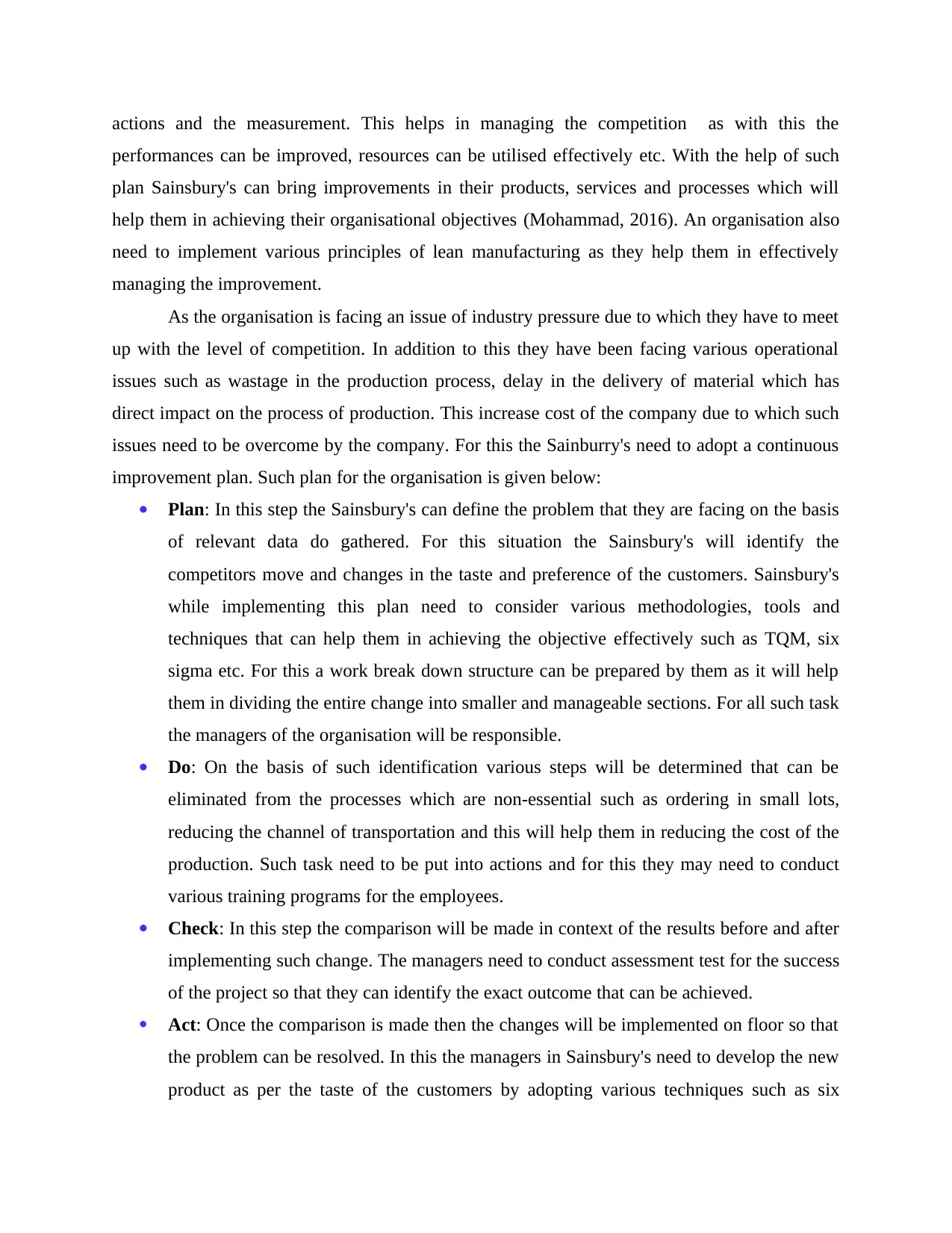
actions and the measurement. This helps in managing the competition as with this the
performances can be improved, resources can be utilised effectively etc. With the help of such
plan Sainsbury's can bring improvements in their products, services and processes which will
help them in achieving their organisational objectives (Mohammad, 2016). An organisation also
need to implement various principles of lean manufacturing as they help them in effectively
managing the improvement.
As the organisation is facing an issue of industry pressure due to which they have to meet
up with the level of competition. In addition to this they have been facing various operational
issues such as wastage in the production process, delay in the delivery of material which has
direct impact on the process of production. This increase cost of the company due to which such
issues need to be overcome by the company. For this the Sainburry's need to adopt a continuous
improvement plan. Such plan for the organisation is given below:
Plan: In this step the Sainsbury's can define the problem that they are facing on the basis
of relevant data do gathered. For this situation the Sainsbury's will identify the
competitors move and changes in the taste and preference of the customers. Sainsbury's
while implementing this plan need to consider various methodologies, tools and
techniques that can help them in achieving the objective effectively such as TQM, six
sigma etc. For this a work break down structure can be prepared by them as it will help
them in dividing the entire change into smaller and manageable sections. For all such task
the managers of the organisation will be responsible.
Do: On the basis of such identification various steps will be determined that can be
eliminated from the processes which are non-essential such as ordering in small lots,
reducing the channel of transportation and this will help them in reducing the cost of the
production. Such task need to be put into actions and for this they may need to conduct
various training programs for the employees.
Check: In this step the comparison will be made in context of the results before and after
implementing such change. The managers need to conduct assessment test for the success
of the project so that they can identify the exact outcome that can be achieved.
Act: Once the comparison is made then the changes will be implemented on floor so that
the problem can be resolved. In this the managers in Sainsbury's need to develop the new
product as per the taste of the customers by adopting various techniques such as six
performances can be improved, resources can be utilised effectively etc. With the help of such
plan Sainsbury's can bring improvements in their products, services and processes which will
help them in achieving their organisational objectives (Mohammad, 2016). An organisation also
need to implement various principles of lean manufacturing as they help them in effectively
managing the improvement.
As the organisation is facing an issue of industry pressure due to which they have to meet
up with the level of competition. In addition to this they have been facing various operational
issues such as wastage in the production process, delay in the delivery of material which has
direct impact on the process of production. This increase cost of the company due to which such
issues need to be overcome by the company. For this the Sainburry's need to adopt a continuous
improvement plan. Such plan for the organisation is given below:
Plan: In this step the Sainsbury's can define the problem that they are facing on the basis
of relevant data do gathered. For this situation the Sainsbury's will identify the
competitors move and changes in the taste and preference of the customers. Sainsbury's
while implementing this plan need to consider various methodologies, tools and
techniques that can help them in achieving the objective effectively such as TQM, six
sigma etc. For this a work break down structure can be prepared by them as it will help
them in dividing the entire change into smaller and manageable sections. For all such task
the managers of the organisation will be responsible.
Do: On the basis of such identification various steps will be determined that can be
eliminated from the processes which are non-essential such as ordering in small lots,
reducing the channel of transportation and this will help them in reducing the cost of the
production. Such task need to be put into actions and for this they may need to conduct
various training programs for the employees.
Check: In this step the comparison will be made in context of the results before and after
implementing such change. The managers need to conduct assessment test for the success
of the project so that they can identify the exact outcome that can be achieved.
Act: Once the comparison is made then the changes will be implemented on floor so that
the problem can be resolved. In this the managers in Sainsbury's need to develop the new
product as per the taste of the customers by adopting various techniques such as six
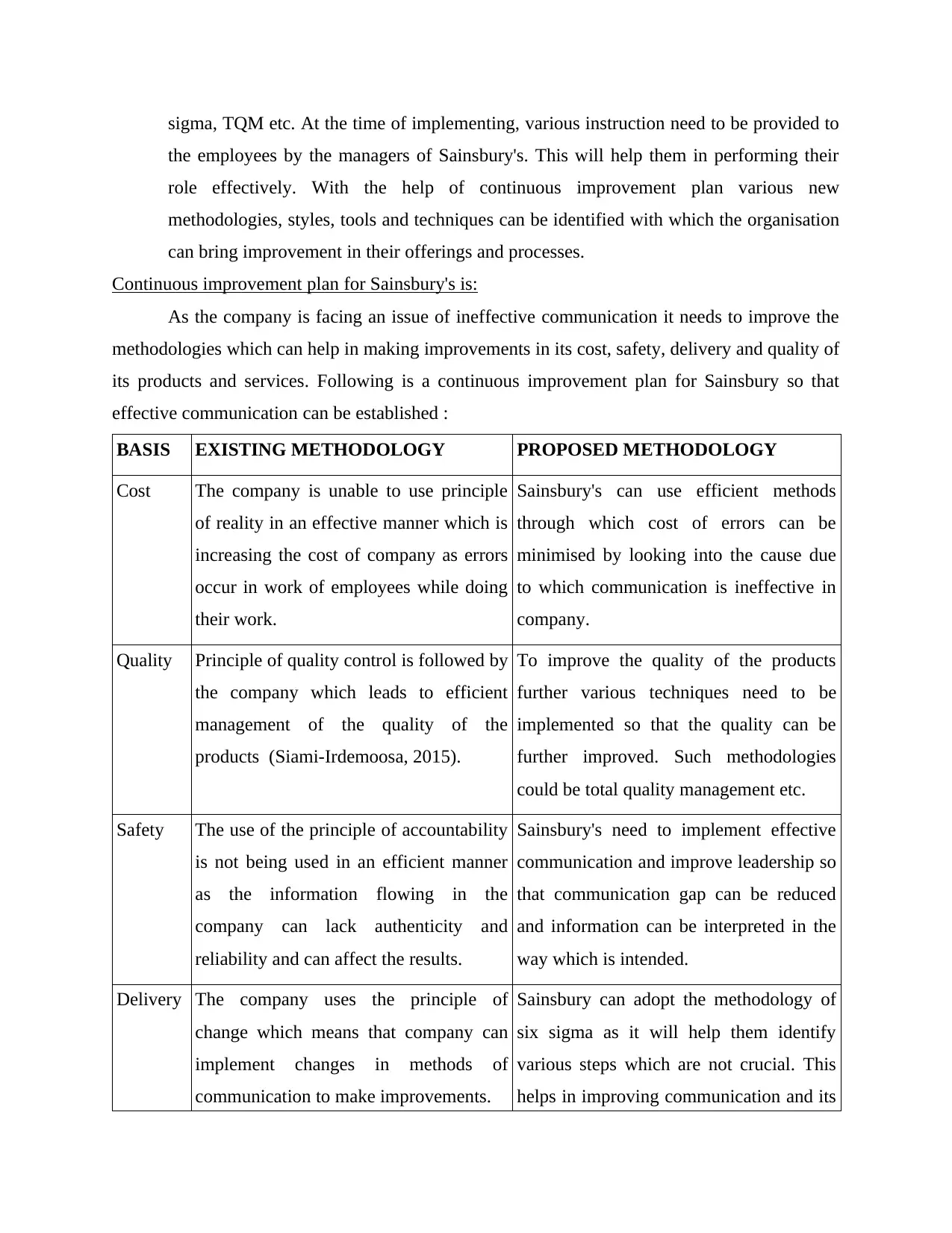
sigma, TQM etc. At the time of implementing, various instruction need to be provided to
the employees by the managers of Sainsbury's. This will help them in performing their
role effectively. With the help of continuous improvement plan various new
methodologies, styles, tools and techniques can be identified with which the organisation
can bring improvement in their offerings and processes.
Continuous improvement plan for Sainsbury's is:
As the company is facing an issue of ineffective communication it needs to improve the
methodologies which can help in making improvements in its cost, safety, delivery and quality of
its products and services. Following is a continuous improvement plan for Sainsbury so that
effective communication can be established :
BASIS EXISTING METHODOLOGY PROPOSED METHODOLOGY
Cost The company is unable to use principle
of reality in an effective manner which is
increasing the cost of company as errors
occur in work of employees while doing
their work.
Sainsbury's can use efficient methods
through which cost of errors can be
minimised by looking into the cause due
to which communication is ineffective in
company.
Quality Principle of quality control is followed by
the company which leads to efficient
management of the quality of the
products (Siami-Irdemoosa, 2015).
To improve the quality of the products
further various techniques need to be
implemented so that the quality can be
further improved. Such methodologies
could be total quality management etc.
Safety The use of the principle of accountability
is not being used in an efficient manner
as the information flowing in the
company can lack authenticity and
reliability and can affect the results.
Sainsbury's need to implement effective
communication and improve leadership so
that communication gap can be reduced
and information can be interpreted in the
way which is intended.
Delivery The company uses the principle of
change which means that company can
implement changes in methods of
communication to make improvements.
Sainsbury can adopt the methodology of
six sigma as it will help them identify
various steps which are not crucial. This
helps in improving communication and its
the employees by the managers of Sainsbury's. This will help them in performing their
role effectively. With the help of continuous improvement plan various new
methodologies, styles, tools and techniques can be identified with which the organisation
can bring improvement in their offerings and processes.
Continuous improvement plan for Sainsbury's is:
As the company is facing an issue of ineffective communication it needs to improve the
methodologies which can help in making improvements in its cost, safety, delivery and quality of
its products and services. Following is a continuous improvement plan for Sainsbury so that
effective communication can be established :
BASIS EXISTING METHODOLOGY PROPOSED METHODOLOGY
Cost The company is unable to use principle
of reality in an effective manner which is
increasing the cost of company as errors
occur in work of employees while doing
their work.
Sainsbury's can use efficient methods
through which cost of errors can be
minimised by looking into the cause due
to which communication is ineffective in
company.
Quality Principle of quality control is followed by
the company which leads to efficient
management of the quality of the
products (Siami-Irdemoosa, 2015).
To improve the quality of the products
further various techniques need to be
implemented so that the quality can be
further improved. Such methodologies
could be total quality management etc.
Safety The use of the principle of accountability
is not being used in an efficient manner
as the information flowing in the
company can lack authenticity and
reliability and can affect the results.
Sainsbury's need to implement effective
communication and improve leadership so
that communication gap can be reduced
and information can be interpreted in the
way which is intended.
Delivery The company uses the principle of
change which means that company can
implement changes in methods of
communication to make improvements.
Sainsbury can adopt the methodology of
six sigma as it will help them identify
various steps which are not crucial. This
helps in improving communication and its
⊘ This is a preview!⊘
Do you want full access?
Subscribe today to unlock all pages.

Trusted by 1+ million students worldwide
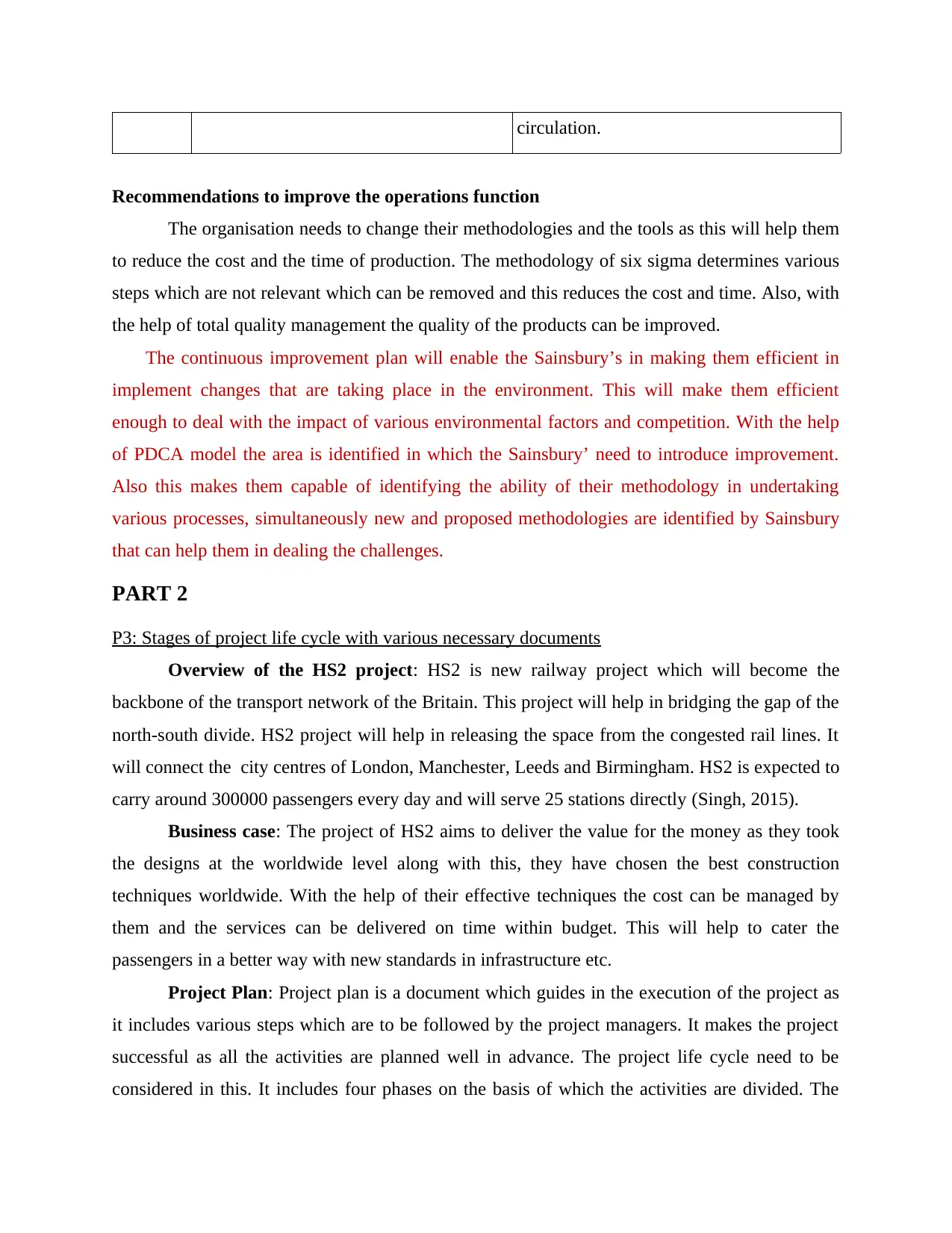
circulation.
Recommendations to improve the operations function
The organisation needs to change their methodologies and the tools as this will help them
to reduce the cost and the time of production. The methodology of six sigma determines various
steps which are not relevant which can be removed and this reduces the cost and time. Also, with
the help of total quality management the quality of the products can be improved.
The continuous improvement plan will enable the Sainsbury’s in making them efficient in
implement changes that are taking place in the environment. This will make them efficient
enough to deal with the impact of various environmental factors and competition. With the help
of PDCA model the area is identified in which the Sainsbury’ need to introduce improvement.
Also this makes them capable of identifying the ability of their methodology in undertaking
various processes, simultaneously new and proposed methodologies are identified by Sainsbury
that can help them in dealing the challenges.
PART 2
P3: Stages of project life cycle with various necessary documents
Overview of the HS2 project: HS2 is new railway project which will become the
backbone of the transport network of the Britain. This project will help in bridging the gap of the
north-south divide. HS2 project will help in releasing the space from the congested rail lines. It
will connect the city centres of London, Manchester, Leeds and Birmingham. HS2 is expected to
carry around 300000 passengers every day and will serve 25 stations directly (Singh, 2015).
Business case: The project of HS2 aims to deliver the value for the money as they took
the designs at the worldwide level along with this, they have chosen the best construction
techniques worldwide. With the help of their effective techniques the cost can be managed by
them and the services can be delivered on time within budget. This will help to cater the
passengers in a better way with new standards in infrastructure etc.
Project Plan: Project plan is a document which guides in the execution of the project as
it includes various steps which are to be followed by the project managers. It makes the project
successful as all the activities are planned well in advance. The project life cycle need to be
considered in this. It includes four phases on the basis of which the activities are divided. The
Recommendations to improve the operations function
The organisation needs to change their methodologies and the tools as this will help them
to reduce the cost and the time of production. The methodology of six sigma determines various
steps which are not relevant which can be removed and this reduces the cost and time. Also, with
the help of total quality management the quality of the products can be improved.
The continuous improvement plan will enable the Sainsbury’s in making them efficient in
implement changes that are taking place in the environment. This will make them efficient
enough to deal with the impact of various environmental factors and competition. With the help
of PDCA model the area is identified in which the Sainsbury’ need to introduce improvement.
Also this makes them capable of identifying the ability of their methodology in undertaking
various processes, simultaneously new and proposed methodologies are identified by Sainsbury
that can help them in dealing the challenges.
PART 2
P3: Stages of project life cycle with various necessary documents
Overview of the HS2 project: HS2 is new railway project which will become the
backbone of the transport network of the Britain. This project will help in bridging the gap of the
north-south divide. HS2 project will help in releasing the space from the congested rail lines. It
will connect the city centres of London, Manchester, Leeds and Birmingham. HS2 is expected to
carry around 300000 passengers every day and will serve 25 stations directly (Singh, 2015).
Business case: The project of HS2 aims to deliver the value for the money as they took
the designs at the worldwide level along with this, they have chosen the best construction
techniques worldwide. With the help of their effective techniques the cost can be managed by
them and the services can be delivered on time within budget. This will help to cater the
passengers in a better way with new standards in infrastructure etc.
Project Plan: Project plan is a document which guides in the execution of the project as
it includes various steps which are to be followed by the project managers. It makes the project
successful as all the activities are planned well in advance. The project life cycle need to be
considered in this. It includes four phases on the basis of which the activities are divided. The
Paraphrase This Document
Need a fresh take? Get an instant paraphrase of this document with our AI Paraphraser
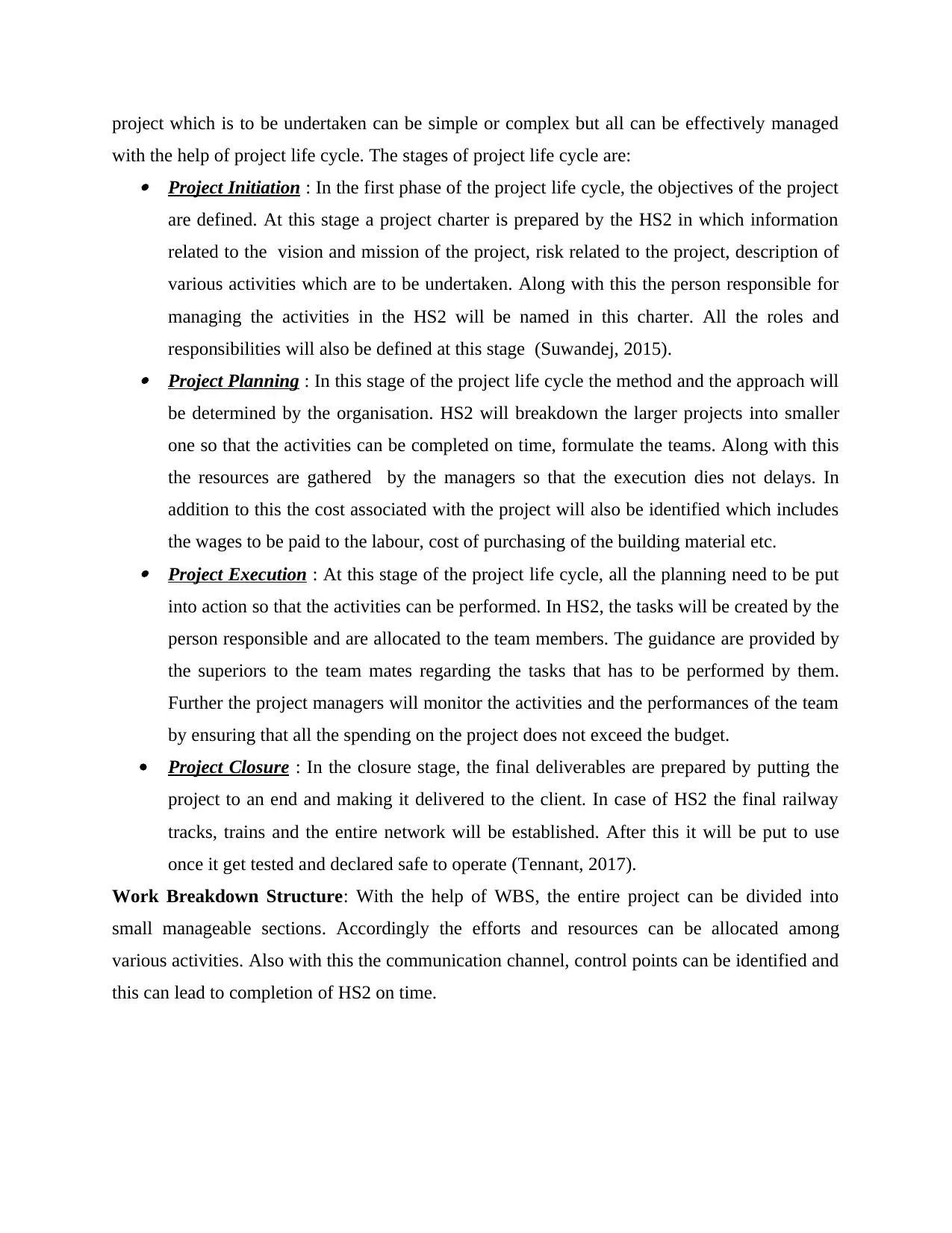
project which is to be undertaken can be simple or complex but all can be effectively managed
with the help of project life cycle. The stages of project life cycle are: Project Initiation : In the first phase of the project life cycle, the objectives of the project
are defined. At this stage a project charter is prepared by the HS2 in which information
related to the vision and mission of the project, risk related to the project, description of
various activities which are to be undertaken. Along with this the person responsible for
managing the activities in the HS2 will be named in this charter. All the roles and
responsibilities will also be defined at this stage (Suwandej, 2015). Project Planning : In this stage of the project life cycle the method and the approach will
be determined by the organisation. HS2 will breakdown the larger projects into smaller
one so that the activities can be completed on time, formulate the teams. Along with this
the resources are gathered by the managers so that the execution dies not delays. In
addition to this the cost associated with the project will also be identified which includes
the wages to be paid to the labour, cost of purchasing of the building material etc. Project Execution : At this stage of the project life cycle, all the planning need to be put
into action so that the activities can be performed. In HS2, the tasks will be created by the
person responsible and are allocated to the team members. The guidance are provided by
the superiors to the team mates regarding the tasks that has to be performed by them.
Further the project managers will monitor the activities and the performances of the team
by ensuring that all the spending on the project does not exceed the budget.
Project Closure : In the closure stage, the final deliverables are prepared by putting the
project to an end and making it delivered to the client. In case of HS2 the final railway
tracks, trains and the entire network will be established. After this it will be put to use
once it get tested and declared safe to operate (Tennant, 2017).
Work Breakdown Structure: With the help of WBS, the entire project can be divided into
small manageable sections. Accordingly the efforts and resources can be allocated among
various activities. Also with this the communication channel, control points can be identified and
this can lead to completion of HS2 on time.
with the help of project life cycle. The stages of project life cycle are: Project Initiation : In the first phase of the project life cycle, the objectives of the project
are defined. At this stage a project charter is prepared by the HS2 in which information
related to the vision and mission of the project, risk related to the project, description of
various activities which are to be undertaken. Along with this the person responsible for
managing the activities in the HS2 will be named in this charter. All the roles and
responsibilities will also be defined at this stage (Suwandej, 2015). Project Planning : In this stage of the project life cycle the method and the approach will
be determined by the organisation. HS2 will breakdown the larger projects into smaller
one so that the activities can be completed on time, formulate the teams. Along with this
the resources are gathered by the managers so that the execution dies not delays. In
addition to this the cost associated with the project will also be identified which includes
the wages to be paid to the labour, cost of purchasing of the building material etc. Project Execution : At this stage of the project life cycle, all the planning need to be put
into action so that the activities can be performed. In HS2, the tasks will be created by the
person responsible and are allocated to the team members. The guidance are provided by
the superiors to the team mates regarding the tasks that has to be performed by them.
Further the project managers will monitor the activities and the performances of the team
by ensuring that all the spending on the project does not exceed the budget.
Project Closure : In the closure stage, the final deliverables are prepared by putting the
project to an end and making it delivered to the client. In case of HS2 the final railway
tracks, trains and the entire network will be established. After this it will be put to use
once it get tested and declared safe to operate (Tennant, 2017).
Work Breakdown Structure: With the help of WBS, the entire project can be divided into
small manageable sections. Accordingly the efforts and resources can be allocated among
various activities. Also with this the communication channel, control points can be identified and
this can lead to completion of HS2 on time.
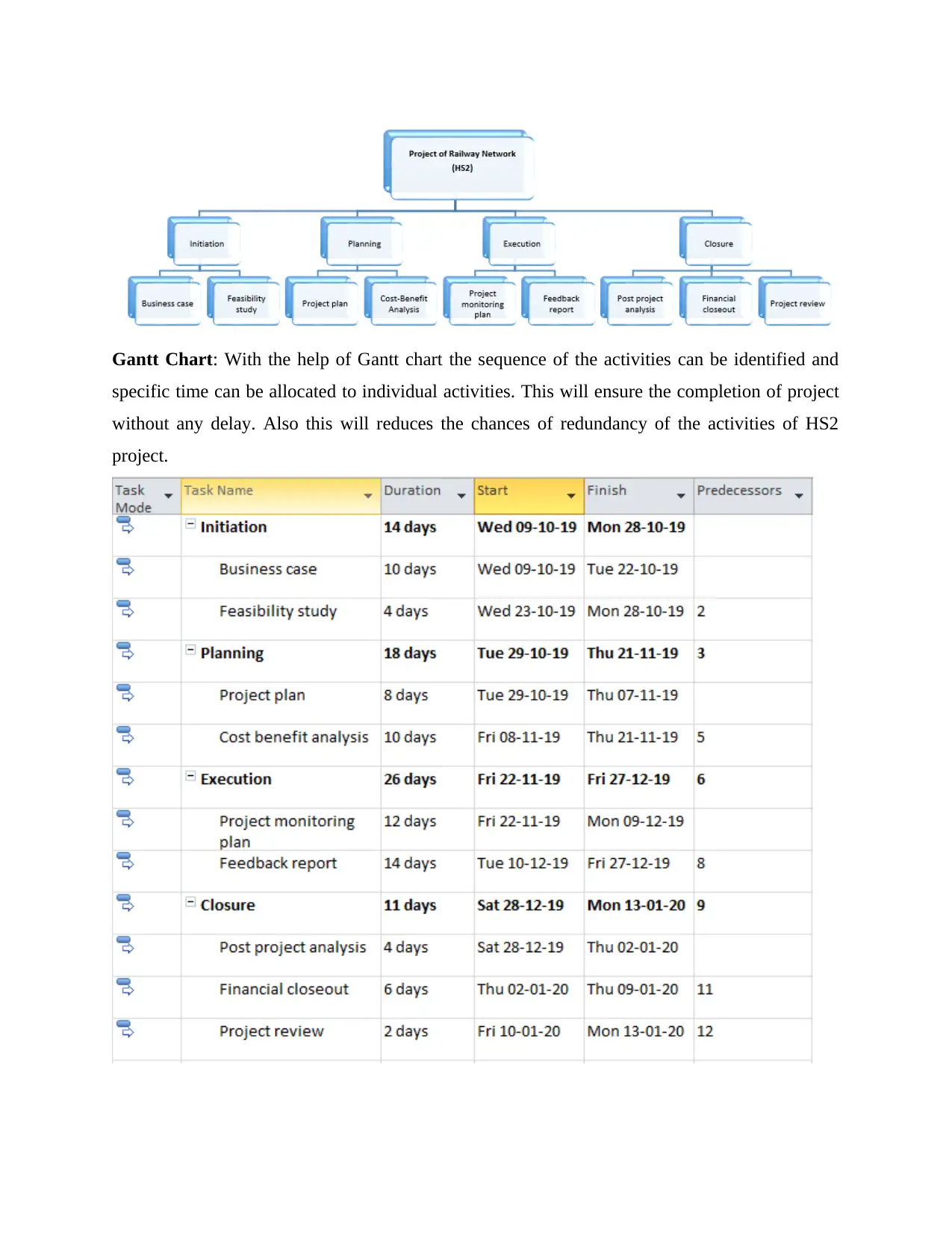
Gantt Chart: With the help of Gantt chart the sequence of the activities can be identified and
specific time can be allocated to individual activities. This will ensure the completion of project
without any delay. Also this will reduces the chances of redundancy of the activities of HS2
project.
specific time can be allocated to individual activities. This will ensure the completion of project
without any delay. Also this will reduces the chances of redundancy of the activities of HS2
project.
⊘ This is a preview!⊘
Do you want full access?
Subscribe today to unlock all pages.

Trusted by 1+ million students worldwide
1 out of 19
Related Documents
Your All-in-One AI-Powered Toolkit for Academic Success.
+13062052269
info@desklib.com
Available 24*7 on WhatsApp / Email
![[object Object]](/_next/static/media/star-bottom.7253800d.svg)
Unlock your academic potential
Copyright © 2020–2025 A2Z Services. All Rights Reserved. Developed and managed by ZUCOL.




